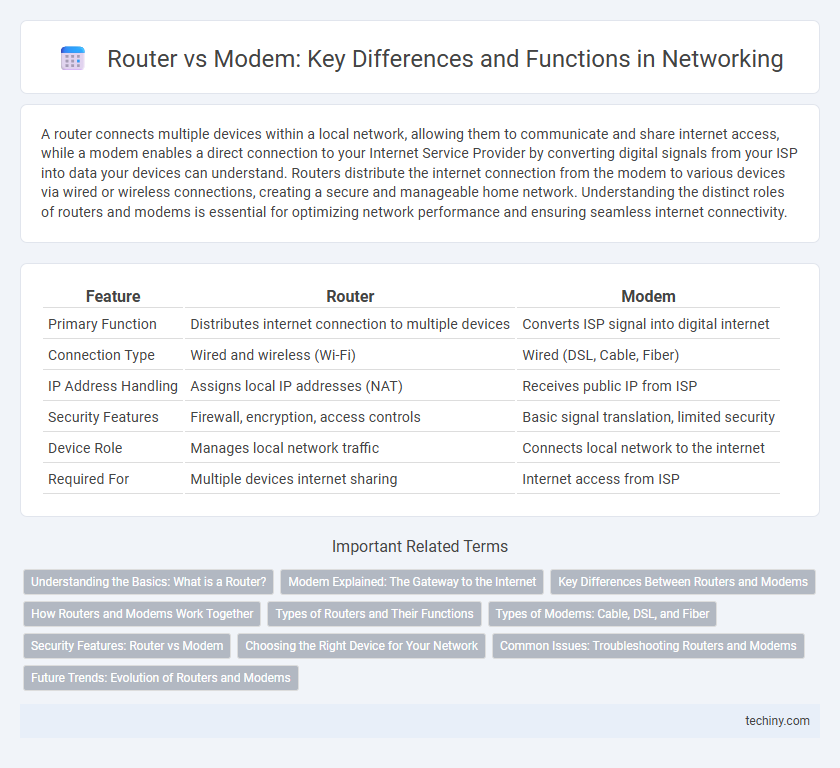A router connects multiple devices within a local network, allowing them to communicate and share internet access, while a modem enables a direct connection to your Internet Service Provider by converting digital signals from your ISP into data your devices can understand. Routers distribute the internet connection from the modem to various devices via wired or wireless connections, creating a secure and manageable home network. Understanding the distinct roles of routers and modems is essential for optimizing network performance and ensuring seamless internet connectivity.
Table of Comparison
| Feature | Router | Modem |
|---|---|---|
| Primary Function | Distributes internet connection to multiple devices | Converts ISP signal into digital internet |
| Connection Type | Wired and wireless (Wi-Fi) | Wired (DSL, Cable, Fiber) |
| IP Address Handling | Assigns local IP addresses (NAT) | Receives public IP from ISP |
| Security Features | Firewall, encryption, access controls | Basic signal translation, limited security |
| Device Role | Manages local network traffic | Connects local network to the internet |
| Required For | Multiple devices internet sharing | Internet access from ISP |
Understanding the Basics: What is a Router?
A router is a networking device that directs data packets between multiple computer networks, primarily connecting local devices to the internet via a modem. It assigns local IP addresses, manages traffic by routing data efficiently to ensure devices communicate seamlessly, and often includes built-in security features like firewalls. Unlike a modem, which converts signals for internet access, the router creates and maintains a local area network (LAN) to enable device interconnectivity and internet sharing.
Modem Explained: The Gateway to the Internet
A modem serves as the essential gateway to the internet by converting digital data from a computer or router into signals compatible with the Internet Service Provider's infrastructure, such as DSL, cable, or fiber optics. It establishes and maintains the internet connection by modulating and demodulating data signals, allowing devices in a home or business network to access online resources. Unlike routers, which manage local network traffic and device communication, modems handle the direct link between the network and the external internet.
Key Differences Between Routers and Modems
Routers distribute internet connections from modems to multiple devices via wired or wireless networks, managing local IP address assignments and network traffic. Modems modulate and demodulate signals to connect your home network to your Internet Service Provider (ISP) by converting digital data into a format suitable for transmission over telephone, cable, or fiber-optic lines. Key differences include that modems provide internet access by connecting to the ISP, while routers enable multiple device connectivity and network security features within a local area network (LAN).
How Routers and Modems Work Together
A modem connects to the internet service provider to convert digital signals from your home network into a format suitable for transmission over phone, cable, or fiber lines. The router takes the internet connection from the modem and distributes it to multiple devices via Wi-Fi or Ethernet, managing local traffic and assigning IP addresses. Together, the modem provides internet access while the router enables device communication and network security within a local area network (LAN).
Types of Routers and Their Functions
Home routers typically include wired, wireless, and dual-band models, each facilitating device connectivity through Ethernet or Wi-Fi. Enterprise routers provide advanced features like traffic management, VPN support, and enhanced security for large-scale networks. Industrial routers are designed for harsh environments, offering robust connectivity and real-time data transmission for critical infrastructure and IoT applications.
Types of Modems: Cable, DSL, and Fiber
Cable, DSL, and Fiber modems serve distinct functions in internet connectivity, each compatible with specific network infrastructures. Cable modems utilize coaxial cables for high-speed data transmission, ideal for urban and suburban areas with DOCSIS technology support. DSL modems operate over traditional telephone lines, offering reliable internet access in regions without cable infrastructure, while Fiber modems provide ultra-fast internet by converting optical signals in fiber-optic cables, catering to areas with advanced fiber-optic networks.
Security Features: Router vs Modem
Routers offer advanced security features such as firewalls, WPA3 encryption, and intrusion detection systems, providing a robust defense against cyber threats. Modems primarily serve as a bridge between your home network and the ISP, lacking built-in security measures and relying on connected devices for protection. Implementing a router with strong security protocols significantly reduces the risk of unauthorized access and data breaches in a network.
Choosing the Right Device for Your Network
Selecting the right device for your network depends on understanding the distinct roles of routers and modems. A modem connects your local network to the internet by translating signals from your Internet Service Provider (ISP), while a router directs data traffic between devices within your home or office network, providing features like wireless connectivity and network security. For optimal network performance, choose a modem compatible with your ISP's technology and pair it with a router that supports your network size, speed requirements, and security protocols.
Common Issues: Troubleshooting Routers and Modems
Common issues in routers and modems often involve connectivity problems, slow internet speeds, and frequent disconnections. Troubleshooting steps include restarting the device, checking physical cable connections, updating firmware, and resetting to factory settings if necessary. Identifying whether the problem lies with the router or modem is crucial for targeted resolution, often determined through testing with alternate devices or direct modem connections.
Future Trends: Evolution of Routers and Modems
Future trends in networking indicate routers will increasingly integrate advanced AI capabilities for smarter traffic management and enhanced security features, while modems will evolve to support ultra-high-speed connectivity standards like Wi-Fi 7 and 5G. Enhanced interoperability between routers and modems will drive seamless network experiences, reducing latency and boosting broadband efficiency. The rise of mesh networking and IoT compatibility will further shape the convergence of routers and modems, enabling more resilient and adaptive home and enterprise networks.
Router vs Modem Infographic

 techiny.com
techiny.com